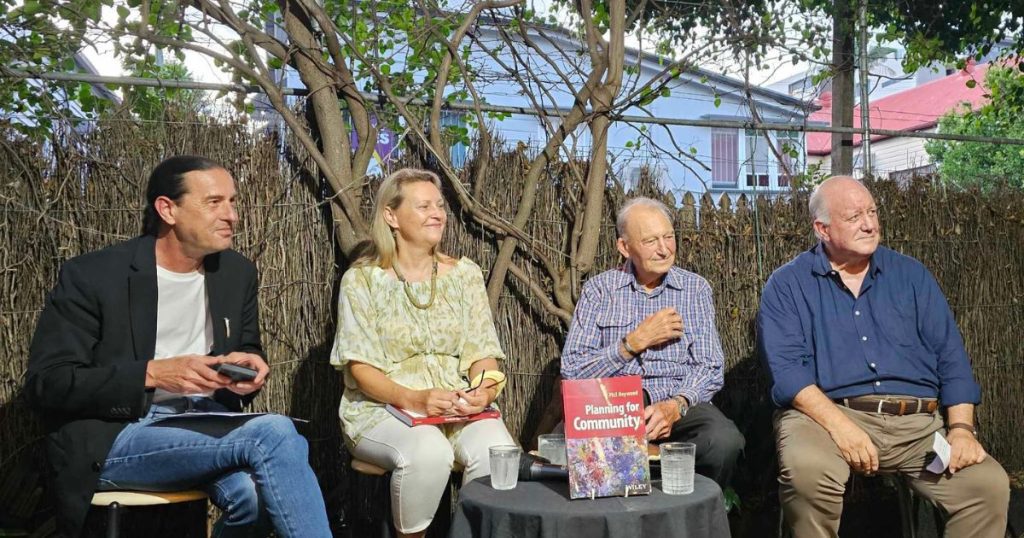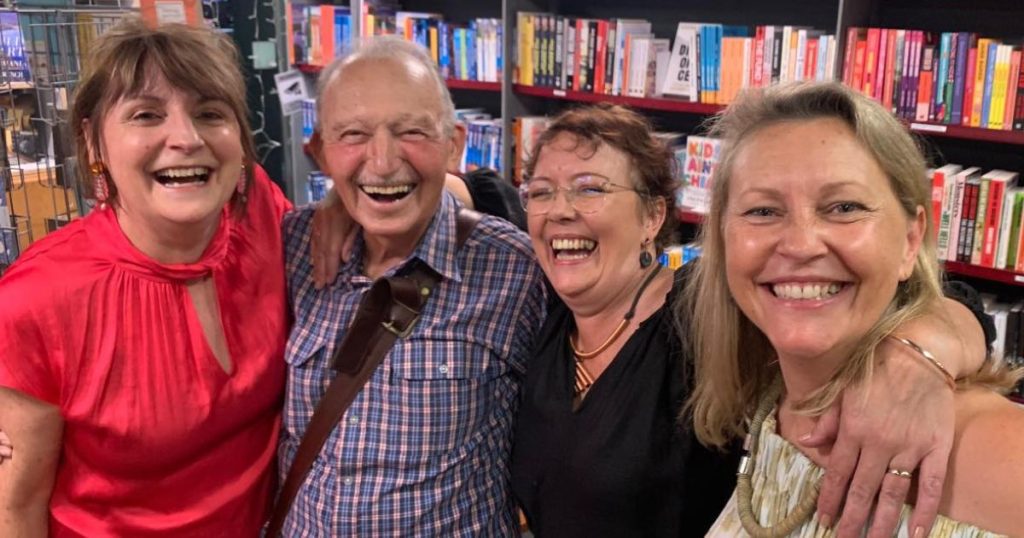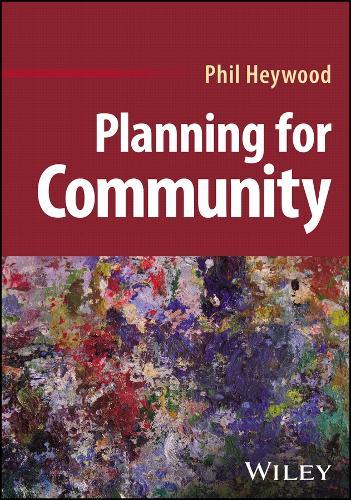Urban Planner Phil Heywood unveiled the latest edition of his 2011 book, “Planning for Community,“[i] at Avid Reader on Friday evening.
Planners Chris Buckley and Vanessa Bennett, along with Joe Hurley of the Brisbane Housing Company, praised Phil for his significant impact and lasting influence on planning in Queensland. Chris Buckley called him an “icon of the profession,” while Vanessa Bennett dubbed him a “national treasure”. Landscape architect John Mongard honoured Phil with a poem.
In our conversation a few weeks before the launch, Phil shared how the principles of community collaboration have shaped his life, from his childhood in wartime London during the bombing blitz of WW2 to his tenure as an urban planning academic in Brisbane.

Early influences
Phil Heywood was born and raised in wartime Britain. He says it was an exhilarating time despite the challenges. He observed the aftermath of bombings, witnessing people helping one another rebuild. This collective response to external threats instilled in Phil a lifelong belief in the power of community collaboration.
After the war, his father, a school dentist, seized an opportunity offered by the Australian government for professionals like him. He was recruited to work as a school dentist in Mackay for two years, a stark contrast to the wartime England he left behind.
Mackay, which has stunning views of the Great Barrier Reef and picturesque landscapes, offered a refreshing change.
“It was a vibrant community with its port, railway, and airport, where locals mingled with visitors worldwide.”
However, tragedy struck when Phil’s brother died in a climbing accident, leaving Phil’s parents deeply affected.
Eventually, the family returned to England, where Phil resumed his education and later earned a scholarship at Oxford. Phil faced a decision regarding national service, grappling with the aftermath of wartime experiences and finally choosing to serve in Nigeria, where he began working with independent African communities after university.
Planning as a career
Phil said Oxford’s School of Geography welcomed him despite his scholarship being in History and English Language, and he studied under the guidance of a ‘fantastic’ tutor, with whom he maintained a lifelong friendship.
The focus on regionalism resonated with Phil, especially considering his experiences in Mackay and the Pioneer Valley. While at Oxford, Phil joined a group expedition to Cyrenaica in Libya for social analysis, forging lasting bonds with his fellow students.
In Africa, Phil transitioned from teaching geography to planning, recognising the need for community-driven solutions. Teaching in Onitsha exposed him to the complexities of urban development. Phil’s experiences there inspired him to pursue planning as a career. He obtained planning qualifications in England and worked in various roles in the Department of the Environment. Despite challenges, including clashes with supervisors over community engagement, Phil found his niche as a planning academic.
The late 1960s and early 1970s were times of profound change and opportunity. Phil married his life partner Sheila, and they started a family in Manchester. They later moved to Liverpool, where he wrote his first book, Planning and Human Needs. Phil oversaw a planning school at Gloucestershire College of Art and Design, now Gloucestershire University, for a decade. The program was transformed from a small rural offering into a nationally respected course during his tenure. However, disillusioned with the conservative atmosphere of 1980s England, Phil heeded a friend’s suggestion to return to Australia.
Back to Queensland
Phil arrived in Brisbane during the vibrant emergence of the city in the 1980s. From 1981 until 2016, Phil taught at the Queensland University of Technology (QUT) as Associate Professor in Urban and Regional Planning. He likens teaching to “gardening with young minds and spirits.”
In addition to teaching, Phil participated in various planning projects and provided advice to the Lord Mayor, Sallyanne Atkinson, on suburban and town planning. Phil’s approach prioritised community collaboration, which he also emphasised in his teaching.
Laurel Johnson, a former student and colleague attended Friday’s launch.
“I, like many other of Phil Heywood’s urban planning students, is heavily influenced by the values, philosophy, and methods expressed in his latest book. We were fortunate to have experienced his fierce intellect and unstoppable energy as his students at QUT. It was not just his words, but also his actions that showed us that community is our client. He often spoke out against the poor planning decisions of successive State and Local Governments and that wasn’t without risk to him. I admire that quality in him,” Laurel said.
She added that Phil’s latest book reminds us of the power of working together and the history of significant wins in Brisbane that were hard won through local activism and collaboration.
“He is a champion of local democracy, and the book takes us to the philosophical and theoretical underpinnings of his commitment to give voice to those without voice. At QUT, we students designed a T-shirt (I still have mine) with the word ‘Bwilliant’ splashed across the front in red. That sums up how we felt about Phil, and it is one of his favourite words too. Shout the word ‘bwilliant’ when you read the book. It lightens the soul in these uncertain times.”

Planning for Community
Phil distilled these views on society and community planning in his 2011 book as encapsulating experiences and hopes and pathways for the future.
As the world underwent rapid changes, including globalisation, pandemics, and climate change, Phil felt compelled to update his work, completing the new edition after 18 months of rewriting.
“It addresses emerging challenges and the pressing issues that demand attention in our modern world,” he told me.
Phil says his audience includes students, informed community activists, and those involved in supporting and activating a representative democracy. The updated edition, prompted by the relevance of its themes in the modern world, offers solutions that prioritise collaboration and community involvement over top-down approaches. And, it aims to combat alienation and provide alternatives to government-driven models.
Three standout cases of community-led solutions
Phil outlinedwhat he considers are three standout cases of community-led solutions in planning. The first dates back to the mid-1980s and involves Norman Creek. Various government departments proposed acquiring land along the creek, burying it in large pipes under fifty metres of landfill, and constructing urban freeways on top to address flooding. The local community sought help from the Planning Practice Unit of the Urban and Regional Planning Postgraduate Planning Course at QUT which Phil was running. The unit collaborated with the students on a community-based plan, which eventually led to the adoption of the Norman Creek Action Plan by the Brisbane City Council, conserving the valley in its natural state as a much loved open space creek corridor and becoming the first of many others throughout Brisbane. Phil believed this initiative also served as a model for later community involvement in environmental planning throughout Brisbane, empowering action committees and enhancing local democracy.
Phil’s second example concerns the redevelopment of South Bank after the Bicentennial Expo. Initially, there were attempts to exploit the land for commercial interests, but concerned citizens, including Phil and fellow professionals, urged a reconsideration of the project scale and principles. Militant community opposition led to consultation and political engagement advocating continuous public access to the river, community-based land uses, preservation of views, and creation of free, public recreational spaces. A resulting design competition led to the creation of South Bank as the popular public space we know today, which Phil says is a testament to collaborative planning transcending party politics.
Preserving urban spaces like Mount Coot-tha is another example of a community success story in Queensland, Phil says. Despite ongoing challenges and attempts to commercialise these areas, local groups have consistently opposed such plans and advocated preserving these natural spaces for public enjoyment. Phil argues this demonstrates the ongoing need for community involvement to safeguard the interests of residents and protect valuable environments from encroaching commercial interests.
Phil says these three examples underscore the importance of community involvement in decision-making processes, especially in an era of fragile representative democracy. He advocates for the principle of subsidiarity, which suggests that governance should devolve to the lowest practical level.
“Engaging citizens at different scales, from the neighbourhood to the global can ensure that planning decisions align with local needs and experiences, revitalising our democratic institutions.”
The future of community planning
Looking ahead, Phil says the future of community planning in Queensland remains contested. Market forces often dominate planning decisions, but community groups play a crucial role in challenging these forces and advocating for the interests of residents. He says the rise of independent ‘Teal’ and Greens representatives in political spheres signals a growing recognition of the importance of community voices in decision-making processes.
“Collaboration between community groups and political representatives is critical to empowering local communities and ensuring that planning decisions align with their needs and aspirations.”
While there are diverse visions for the future, Phil says, effective communication and discussion remains fundamental to shaping the direction of community planning efforts.
“From community gardens to the establishment of economic cooperatives, there are various avenues for communities to plan their futures collectively and assert their interests in the face of external pressures. By embracing collaboration and dialogue, communities can navigate challenges and shape a more inclusive and sustainable future not only in Queensland but also worldwide.”

You can purchase a copy of Planning for Community at Avid Reader Bookshop, or, as Phil also suggests, borrow a copy from your local library.
Reposted from the original by Jan Bowman at https://www.westendstreaming.com/planning-for-community-phil-heywood/


Latest Comments